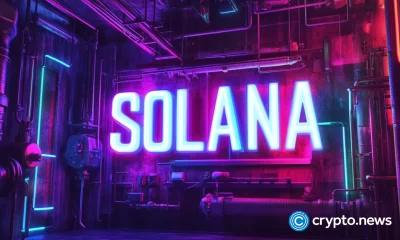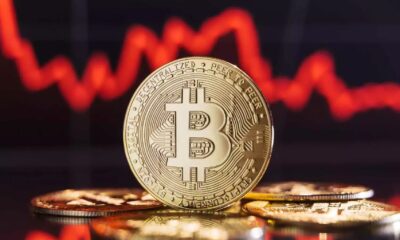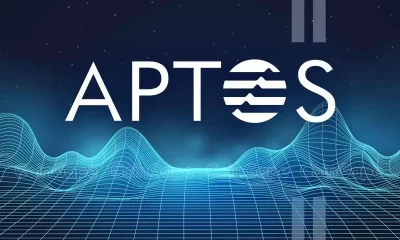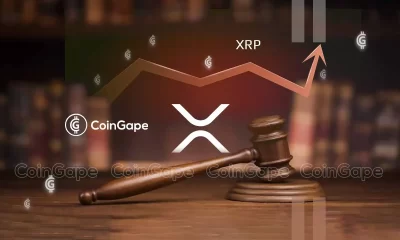Exchange
OKX achieves milestone year in global expansion and innovation, despite challenges
Published
3 months agoon
By
admin

Record app downloads, millions of users, and new in-app features mark the year of recovery and drive OKX’s success.
With millions of new users and an impressive 122% year-over-year rise in app downloads, OKX’s 2024 has been a transformative year characterized by resilience and innovation. The CEO of OKX, Star Xu, stated, “Despite the challenges, 2024 remains a year of focus, innovation, and resilience.”
The company highlighted major achievements, including an increase of 991% global growth in OKX Wallet users by December and a 20x increase in daily trading volume on its decentralized exchange. This expansion underscores the crypto sector’s overall revival, which the CEO called “an important turning point for the industry.”
Despite the ongoing success, OKX has encountered several challenges, especially in the areas of platform security and regulatory oversight. Following reports of security flaws, OKX recently saw huge money withdrawals, with consumers taking out almost $837 million in a single week.
Questions over the platform’s general security mechanism and stories of SIM swap attacks, in which hackers obtained access to users’ accounts, were the catalysts for these withdrawals.
Unlike decentralized exchanges, where users retain control over their trades and assets, OKX which was established in 2017 is a centralized exchange, which means it is run by a single organization. A more streamlined and user-friendly experience is made possible by centralization, but it also implies that OKX itself stores and manages user funds and personal data. A single hack may undermine the entire platform, impacting hundreds or even millions of users, and making centralized exchanges more susceptible to attacks.
Decentralized exchanges, on the other hand, divide authority among multiple participants, which can provide extra security because there isn’t a single central target for an attack. The drawback is that DEXs typically have more intricate procedures and user interfaces.
For OKX, this concentration of power has turned out to be both a benefit and a drawback. Although it provides more efficient services due to centralization, recent security breaches show that it also makes the platform a prime target for hackers and places the onus of user protection squarely on the platform.
To improve the user experience, OKX introduced a streamlined “simple mode” in its app for intuitive trading, enhanced cross-chain support across 100+ blockchains, and added over 200 new features to its services. “This year, we’re working to optimize the use of the app and enhance the seamless experience of crypto assets on OKX,” said the CEO.
In 2024, OKX accelerated its global expansion by establishing localized operations in Brazil, Singapore, and Australia. The company’s dedication to compliance and transparency was demonstrated by securing four significant regulatory licenses in key regions: Singapore, the UAE, the European Economic Area, and Australia.
With an industry-first Proof of Reserves tool and close to 500 compliance specialists, OKX continues to set the standard for protecting user confidence. “To date, more than 2 million users have used our Proof of Reserves verification tool,” said the CEO.
As OKX continues its expansion into new international markets, its rebranding and focus on global compliance highlight the growing competition among centralized exchanges. Competitors of OKX, such as Binance, have also faced regulatory challenges.
However, despite ongoing regulatory scrutiny, OKX remains a major player in the space, continuing to dominate as one of the largest exchanges in the world. This intensifies the competition for market share, with OKX aiming to strengthen its position and capitalize on its recent expansion initiatives.
Source link
You may like


OKX Pauses DEX Aggregator to Address Security Concerns


Trump’s second ex-wife calls for end of prosecution against Roger Ver


SEC Commissioner Hester Peirce on the New Crypto Task Force


Solana Hits 400B Transactions, Nearly $1T in 5 Years


640,000 Chainlink (LINK) Withdrawn From Exchanges In 24 Hours – Bullish Accumulation?


Traders eye $2.80 Rally As Ripple Files New Trademark
Exchange
How to Prepare for a Major Compliance Failure Settlement: The OKX Approach
Published
3 weeks agoon
February 26, 2025By
admin

Confidential protocols put in place to deal with news of regulatory failings by one of the top-five crypto exchanges, OKX, suggest that the company likely has been expecting a settlement with U.S. authorities for some time.
This happened on Monday when OKX announced a $500 million-plus settlement with the U.S. Department of Justice after failing to secure a money transmitter license and allegedly facilitating $5 billion in “suspicious transactions and criminal proceeds.”
OKX’s meticulous planning makes for some fascinating reading. The secret crisis management document seen by CoinDesk refers to a messaging “SWAT Team” that can be mobilized to implement various ways the firm’s top executives can communicate a settlement via social media and when speaking to reporters.
Well in advance of Monday’s large fine and forfeiture, OKX had produced specific guidance with regards to settling with the DOJ, as well as the U.S. Treasury Department’s Office of Foreign Assets Control (OFAC, or sanctions watchdog), for example.
A favored approach is to point out that the entire crypto industry has been broadly under intense scrutiny and that OKX is cooperating fully with regulators, the document said. This was echoed in Monday’s press release which said OKX “appreciates” the DOJ’s “collaboration.”
Since the administration of President Donald Trump took over last month, the main focus for regulatory agencies in the crypto arena has been to reverse their previously aggressive enforcement stance, with the SEC dropping ongoing litigation and closing investigations. But not so in the case of OKX, which, like Kucoin with its recent $300 million penalty and Binance back in 2023, has been forced into costly settlements.
The guidance refers to what is expected from OKX founder Star Xu, President Hong Fang and other executives when it comes to “their social media actions in two scenarios: 1) Leak before OFAC settlement, 2) upon OFAC settlement.”
Also, on the issue of OFAC, if executives are asked if OKX has served sanctioned markets, one suggestion is to say: “Customers from sanctioned markets slipped through when we had immature compliance controls and systems […] It is a very small and insignificant part of the Okcoin or OKX customer base.”
Indeed, Monday’s press release from OKX acknowledged that U.S. customers were able to trade on the global exchange.
“The total number of U.S. customers involved – which are no longer on the platform – amounted to a small percentage of the Company’s worldwide customer population,” the release said.
Brand awareness
Another priority for OKX is how the firm choreographs its big-ticket sponsorship arrangements with the likes of Manchester City football club, F1 team McLaren and the Tribeca Film Festival. The firm estimates that around $100 million per annum has been spent on these partnerships over the past three years.
The action plan for brand partners involves the OKX marketing chief giving each partner a phone call “at the last hour before the news breaks.”
The recommended strategy here is to say OKX has prepared for a regulatory review, given the heightened scrutiny on crypto firms. If asked why the exchange did not share information about this before, the document states that these are pending inquiries and non-public matters. There is also a bullet point suggesting the CMO and OKX’s head of legal “review clauses in our brand partner contracts again.”
Don’t mention OKB
Another detail that gets attention in the OKX planning document is the exchange’s native cryptocurrency, OKB. An obvious concern in the aftermath of FTX is any suggestion that OKB has been used as collateral or to finance any operations of OKX, as was the case with FTX’s FTT token.
Of course, the OKB exchange token hasn’t been subject to anything like the iniquities of FTX’s exchange token. However, it was involved in a sudden flash crash in January 2024, after which OKX quickly offered to compensate users who had lost out. The token, which has a relatively thin trading volume and liquidity, saw 10 dormant wallets become active and begin trading just before the crash, according to Marina Khaustova, COO Crystal Intelligence, a blockchain analytics firm.
Not long after the OKB crash, OKX executives Tim Byun, the former CEO of OKcoin and head of global government relations, and Head of Product Wei Lan were let go by OKX. A source familiar with the situation said Byun was “sacrificed” following the OKB crash.
Unsurprisingly, the OKX comms protocol emphasizes that execs should “refrain from mentioning OKB and reference this only if asked.”
Media management
Another part of the puzzle is how the exchange should deal with media inquiries. Should OKX receive emails or a phone call from a journalist looking for comment about ongoing investigations, the SWAT Team and PR team should go into action to “buy time by offering up leadership schedules”
Meanwhile, the plan is “to contact key friendly publications for a parallel story to seed in a complimentary narrative to the originating story,” the document states.
“1. Push for delay 2. Confirm friendly publications 3. Asynchronously queue up internal / external comms, so we hit send as the story comes out,” it said.
OKX did not provide a comment by press time
Source link
AI
IP crypto surges over 80% following multiple CEX listings, What is IP?
Published
1 month agoon
February 14, 2025By
admin

IP crypto surged by as much as 81.4% in the past 24 hours of trading after the project secured listings on multiple exchanges following its Layer-1 mainnet launch.
According to data from CoinGecko, Story’s token rose to an intraday high of $2.16 on Feb. 14, with its market cap standing at $456 million. The rally was accompanied by a massive surge in demand and activity, with its daily trading volume soaring by over 400,000% to hover around $347 million.
IP was one of the best-performing assets in the crypto market on the day and was trending on Coingecko when writing.
Most of the gains seen over the past day came after the project officially launched its public mainnet after a nearly six-month testnet phase.
The event coincided with the Token Generation Event for its native token, Story tickered IP, which saw over 1 billion tokens enter circulation as part of its initial distribution. Reports indicate that 25% of the initial 1 billion IP supply has been unlocked, with 58.4% allocated to ecosystem development, the community, the foundation, and initial incentive programs.
Following the mainnet launch, IP secured listings on multiple top-tier centralized exchanges, including Coinbase, OKX, KuCoin, Bybit, Bitget, and Bithumb. Most recently, Binance announced the listing of the IP/USDT perpetual contract with up to 25x leverage.
The open interest in the IP futures market has also surged from $92.2k to over $90 million in the past 24 hours, per CoinGlass data.
What is Story Protocol?
Story Protocol is a Layer-1 blockchain designed to revolutionize the $61 trillion intellectual property market by providing a programmable and decentralized framework for managing, trading, and monetizing creative assets.
At its core, the network allows IP holders—including creators, brands, and AI-driven products—to register, tokenize, and govern their digital content on-chain. Users can set custom rules for licensing, modification, and monetization.
The protocol is powered by the IP token, which will serve as the ecosystem’s currency for transactions, governance, and creator rewards. Developers can build on the network, enabling applications such as AI tools, licensing platforms, and decentralized IP marketplaces.
Story Protocol has raised $140 million from investors like a16z and Samsung Next.
Source link
Exchange
Hong Kong gives conditional licenses to four crypto exchanges
Published
3 months agoon
December 18, 2024By
admin

The Hong Kong Securities and Futures Commission has granted conditional licenses to four virtual asset trading platforms.
The platforms — Accumulus GBA Technology, DFX Labs, Hong Kong Digital Asset EX, and Thousand Whales Technology — must meet specific regulatory conditions before fully operating, according to the SFC.
The licenses follow the SFC’s risk-based inspections introduced in June. These inspections are designed to evaluate compliance with Hong Kong’s virtual asset regulations, aiming to protect investors while fostering growth in the crypto sector.
To proceed, the licensed exchanges must complete third-party vulnerability assessments and penetration tests. These tests identify and address potential security weaknesses, ensuring the platforms are capable of securely handling digital asset trading.
The SFC will oversee the process and assess whether the platforms have resolved issues identified during inspections.
The Hong Kong SFC has approved four new cryptocurrency exchanges.
1) Accumulus GBA Technology
2) DFX Labs
3) Hong Kong Digital Asset EX
4) Thousand Whales TechnologyThis brings the total number of licensed virtual asset trading platforms in Hong Kong to 7. #Bitcoin… pic.twitter.com/akt9NzpMFP
— StellDex™ (@StellDex_HQ) December 18, 2024
SFC’s inspections and expecations
According to Dr. Eric Yip, the SFC’s Executive Director of Intermediaries, the regulator has worked closely with the management of these platforms to clarify expectations and speed up the licensing process.
This proactive engagement will continue into the second phase of assessments, during which external assessors will evaluate the platforms under SFC supervision. Upon successful completion of this phase and satisfaction of all conditions, the exchanges will be able to expand their business operations.
The SFC has also issued a circular outlining the roadmap for the licensing process. This guidance aims to streamline the compliance journey for virtual asset trading platforms while reinforcing regulatory standards.
For those unfamiliar with crypto regulation, licenses like these ensure exchanges operate legally and securely. Licensed platforms must implement measures to safeguard user funds, prevent fraud, and deter market manipulation.
Source link

OKX Pauses DEX Aggregator to Address Security Concerns

Trump’s second ex-wife calls for end of prosecution against Roger Ver

SEC Commissioner Hester Peirce on the New Crypto Task Force

Solana Hits 400B Transactions, Nearly $1T in 5 Years

640,000 Chainlink (LINK) Withdrawn From Exchanges In 24 Hours – Bullish Accumulation?

Traders eye $2.80 Rally As Ripple Files New Trademark

Analyst Says Crypto Whales Loading Up on Ethereum, Accumulating $815,514,345 in ETH in Just Five Days

Bitcoin landfill man loses appeal, says he has one ‘last legal option’

Filmmakers Bet on Web3 to Fix Hollywood Film Financing

Mr. Wonderful says the crypto cowboy era is over. Really?

TON Token Surges 20% as Telegram Founder Recovers Passport From French Authorities

Can Bitcoin Reach $100K After the Upcoming US Fed Decision?

XRP Must Close Above This Level For Bullish Breakout: Analyst

Bitcoin reclaims $80K zone as BNB, TON, GT, ATOM hint at altcoin season

Stock Market To Witness Rallies in Next One to Two Weeks, Predicts Wall Street’s Cantor Fitzgerald – Here’s Why

Arthur Hayes, Murad’s Prediction For Meme Coins, AI & DeFi Coins For 2025

Expert Sees Bitcoin Dipping To $50K While Bullish Signs Persist

Aptos Leverages Chainlink To Enhance Scalability and Data Access

Bitcoin Could Rally to $80,000 on the Eve of US Elections

Sonic Now ‘Golden Standard’ of Layer-2s After Scaling Transactions to 16,000+ per Second, Says Andre Cronje

Institutional Investors Go All In on Crypto as 57% Plan to Boost Allocations as Bull Run Heats Up, Sygnum Survey Reveals

Crypto’s Big Trump Gamble Is Risky

Ripple-SEC Case Ends, But These 3 Rivals Could Jump 500x

Has The Bitcoin Price Already Peaked?

A16z-backed Espresso announces mainnet launch of core product

Xmas Altcoin Rally Insights by BNM Agent I

Blockchain groups challenge new broker reporting rule

Trump’s Coin Is About As Revolutionary As OneCoin

Is $200,000 a Realistic Bitcoin Price Target for This Cycle?

Ripple Vs. SEC, Shiba Inu, US Elections Steal Spotlight
Trending

 24/7 Cryptocurrency News4 months ago
24/7 Cryptocurrency News4 months agoArthur Hayes, Murad’s Prediction For Meme Coins, AI & DeFi Coins For 2025

 Bitcoin2 months ago
Bitcoin2 months agoExpert Sees Bitcoin Dipping To $50K While Bullish Signs Persist

 24/7 Cryptocurrency News2 months ago
24/7 Cryptocurrency News2 months agoAptos Leverages Chainlink To Enhance Scalability and Data Access

 Bitcoin4 months ago
Bitcoin4 months agoBitcoin Could Rally to $80,000 on the Eve of US Elections

 Altcoins2 months ago
Altcoins2 months agoSonic Now ‘Golden Standard’ of Layer-2s After Scaling Transactions to 16,000+ per Second, Says Andre Cronje

 Bitcoin4 months ago
Bitcoin4 months agoInstitutional Investors Go All In on Crypto as 57% Plan to Boost Allocations as Bull Run Heats Up, Sygnum Survey Reveals

 Opinion4 months ago
Opinion4 months agoCrypto’s Big Trump Gamble Is Risky

 Price analysis4 months ago
Price analysis4 months agoRipple-SEC Case Ends, But These 3 Rivals Could Jump 500x


